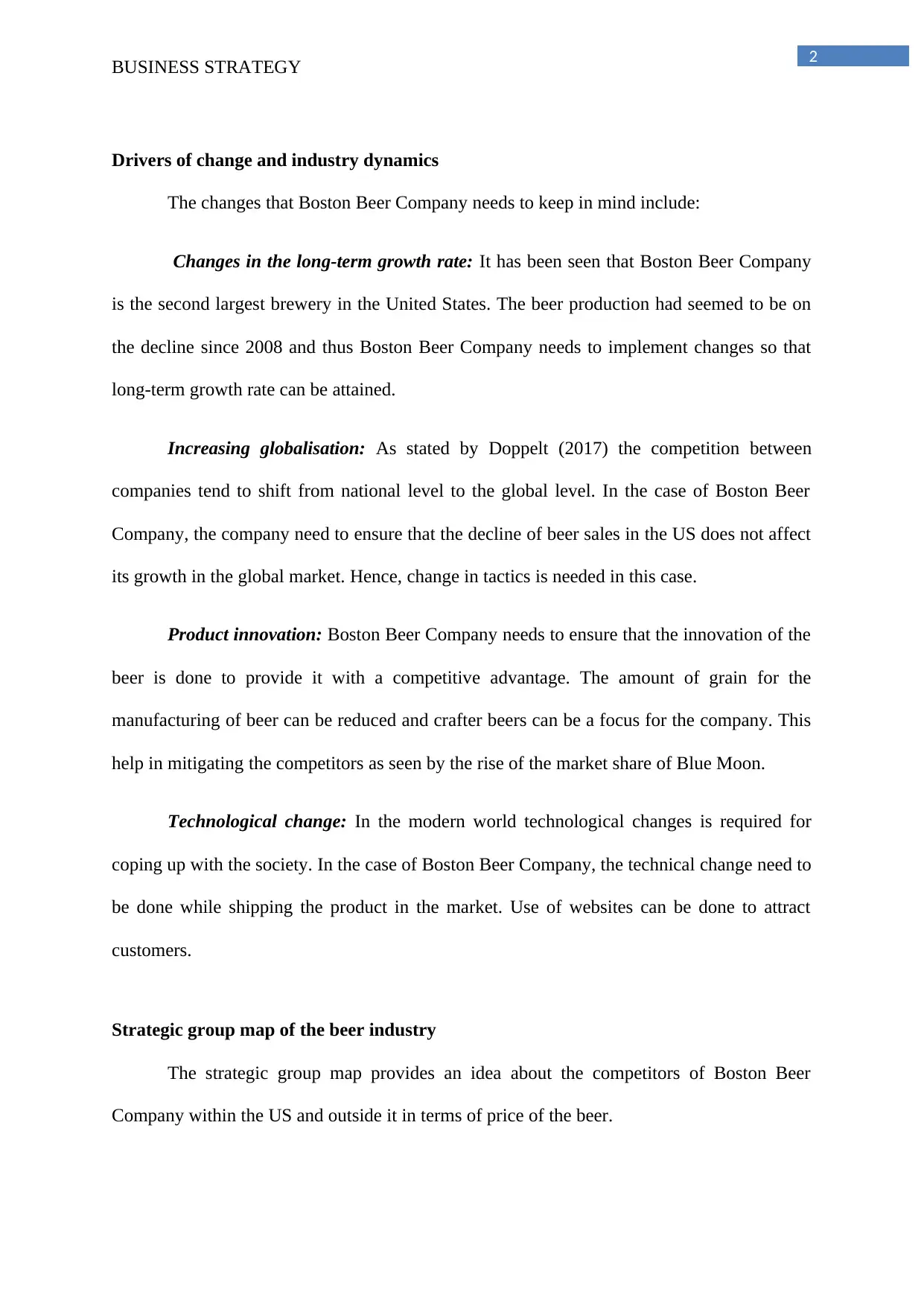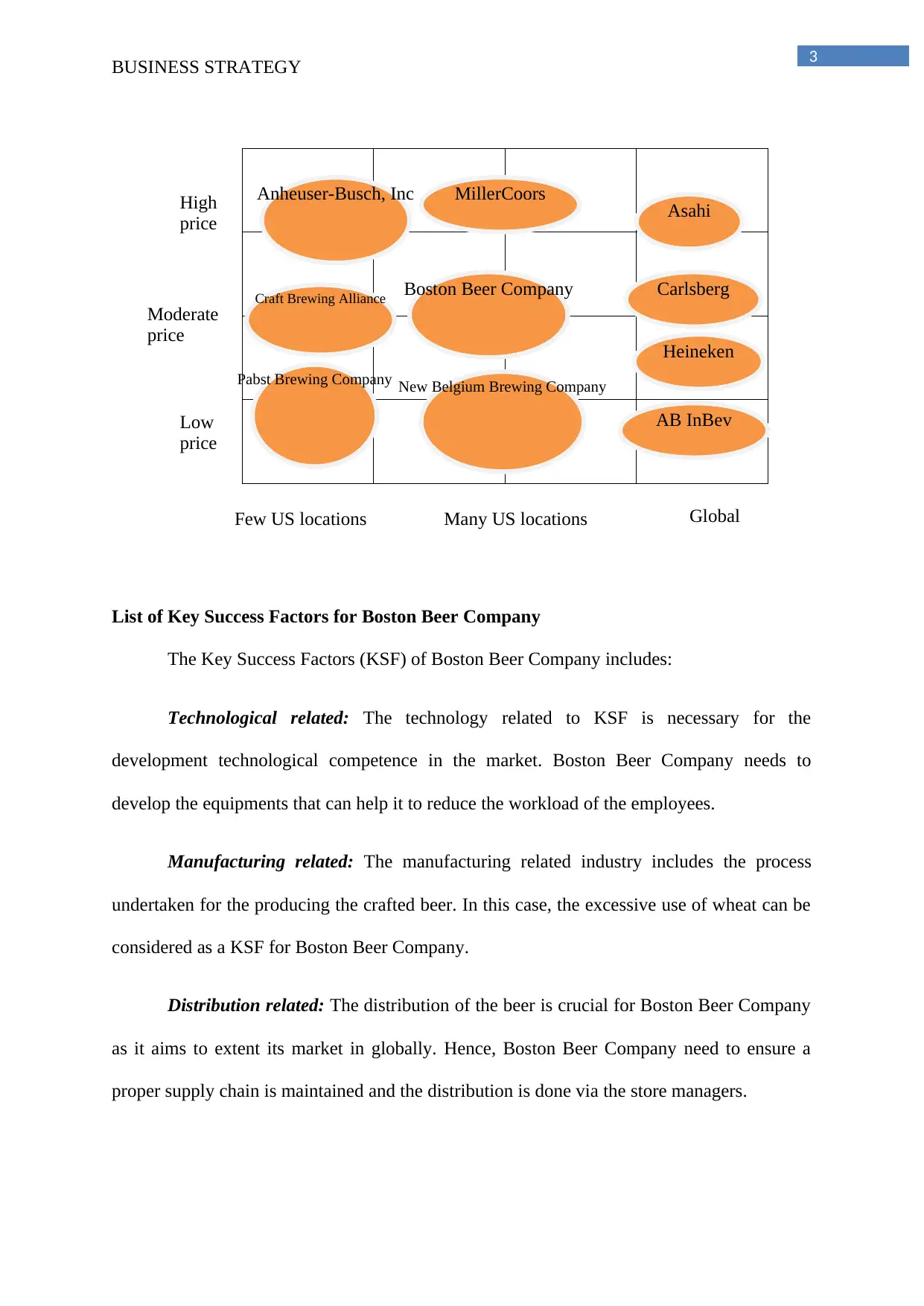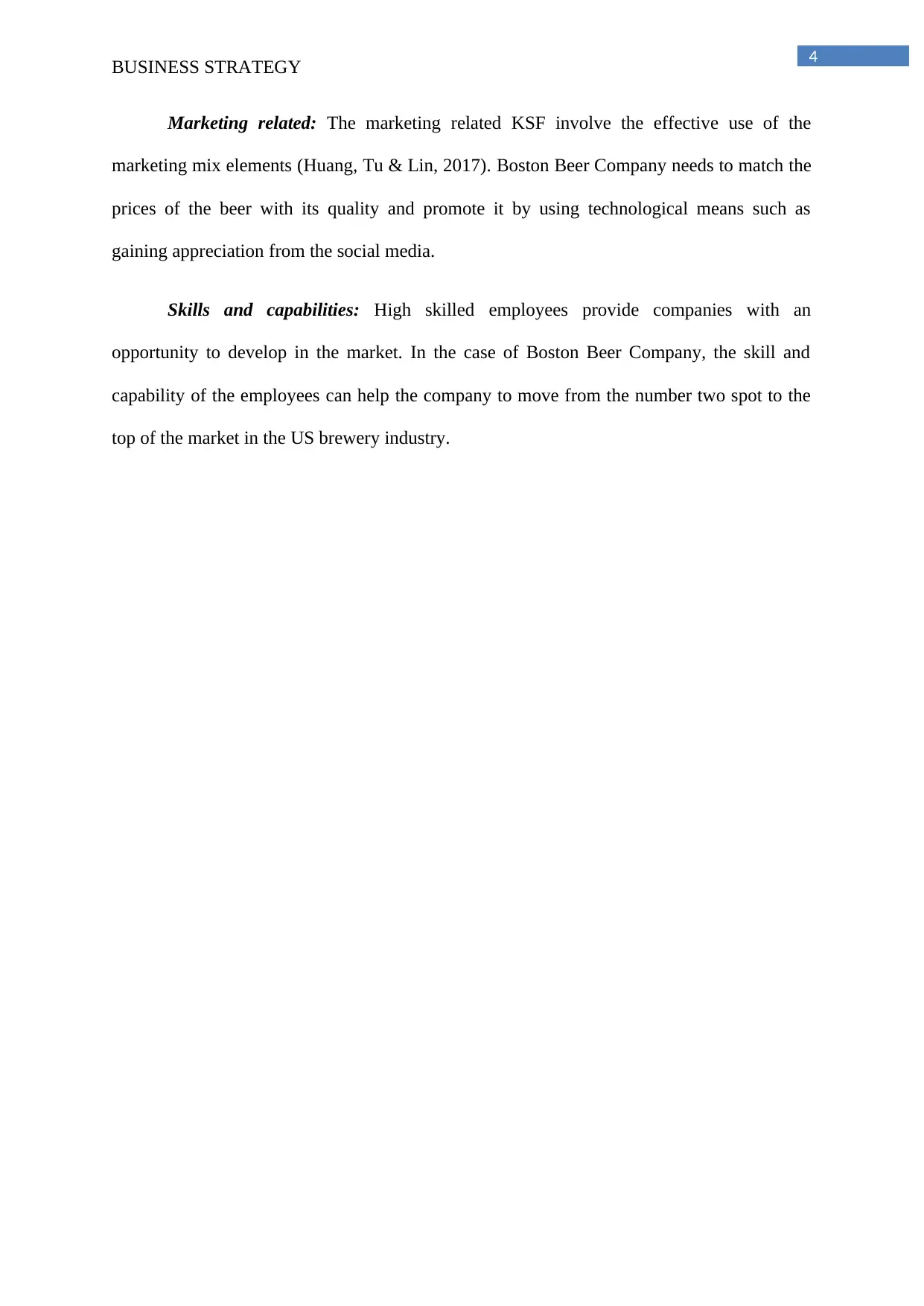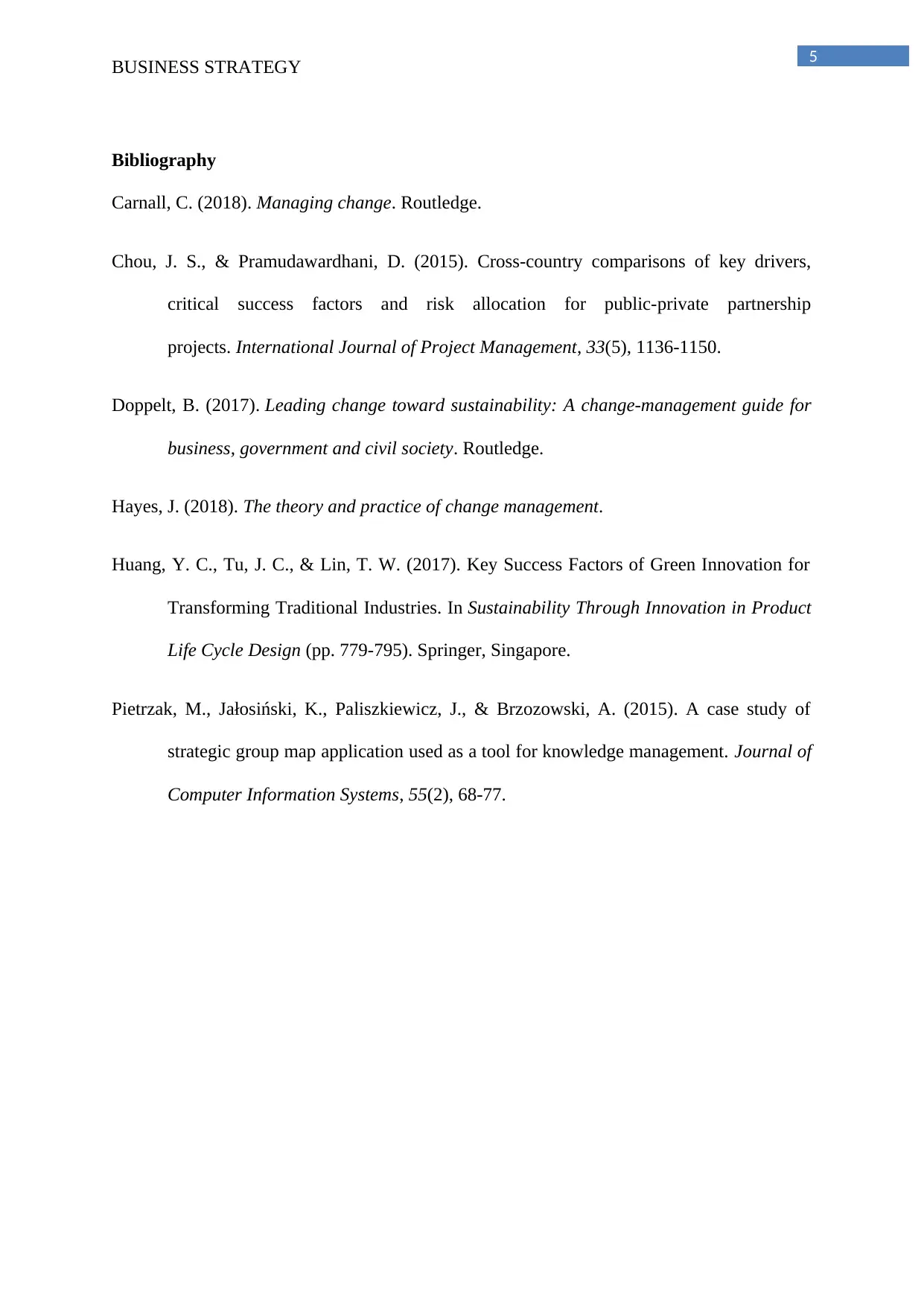Boston Beer Company's Strategic Challenges and Key Success Factors
VerifiedAdded on 2023/06/03
|6
|850
|336
Report
AI Summary
This report provides a comprehensive analysis of Boston Beer Company's business strategy, focusing on the drivers of change and industry dynamics affecting the company. It includes a strategic group map of the beer industry, identifying Boston Beer's competitors based on price and geographic presence. The report also outlines the key success factors (KSFs) for Boston Beer Company, categorized as technological, manufacturing, distribution, and marketing-related, along with essential skills and capabilities. The analysis emphasizes the importance of adapting to changes in long-term growth rate, increasing globalization, product innovation, and technological advancements to maintain a competitive edge in the market. The document is available on Desklib, a platform offering study tools for students.

Running head: BUSINESS STRATEGY
Business Strategy
Name of Student
Name of University
Author Note
Business Strategy
Name of Student
Name of University
Author Note
Paraphrase This Document
Need a fresh take? Get an instant paraphrase of this document with our AI Paraphraser

1
BUSINESS STRATEGY
Table of Contents
Drivers of change and industry dynamics..................................................................................2
Strategic group map of the beer industry...................................................................................2
List of Key Success Factors for Boston Beer Company............................................................3
Bibliography...............................................................................................................................5
BUSINESS STRATEGY
Table of Contents
Drivers of change and industry dynamics..................................................................................2
Strategic group map of the beer industry...................................................................................2
List of Key Success Factors for Boston Beer Company............................................................3
Bibliography...............................................................................................................................5

2
BUSINESS STRATEGY
Drivers of change and industry dynamics
The changes that Boston Beer Company needs to keep in mind include:
Changes in the long-term growth rate: It has been seen that Boston Beer Company
is the second largest brewery in the United States. The beer production had seemed to be on
the decline since 2008 and thus Boston Beer Company needs to implement changes so that
long-term growth rate can be attained.
Increasing globalisation: As stated by Doppelt (2017) the competition between
companies tend to shift from national level to the global level. In the case of Boston Beer
Company, the company need to ensure that the decline of beer sales in the US does not affect
its growth in the global market. Hence, change in tactics is needed in this case.
Product innovation: Boston Beer Company needs to ensure that the innovation of the
beer is done to provide it with a competitive advantage. The amount of grain for the
manufacturing of beer can be reduced and crafter beers can be a focus for the company. This
help in mitigating the competitors as seen by the rise of the market share of Blue Moon.
Technological change: In the modern world technological changes is required for
coping up with the society. In the case of Boston Beer Company, the technical change need to
be done while shipping the product in the market. Use of websites can be done to attract
customers.
Strategic group map of the beer industry
The strategic group map provides an idea about the competitors of Boston Beer
Company within the US and outside it in terms of price of the beer.
BUSINESS STRATEGY
Drivers of change and industry dynamics
The changes that Boston Beer Company needs to keep in mind include:
Changes in the long-term growth rate: It has been seen that Boston Beer Company
is the second largest brewery in the United States. The beer production had seemed to be on
the decline since 2008 and thus Boston Beer Company needs to implement changes so that
long-term growth rate can be attained.
Increasing globalisation: As stated by Doppelt (2017) the competition between
companies tend to shift from national level to the global level. In the case of Boston Beer
Company, the company need to ensure that the decline of beer sales in the US does not affect
its growth in the global market. Hence, change in tactics is needed in this case.
Product innovation: Boston Beer Company needs to ensure that the innovation of the
beer is done to provide it with a competitive advantage. The amount of grain for the
manufacturing of beer can be reduced and crafter beers can be a focus for the company. This
help in mitigating the competitors as seen by the rise of the market share of Blue Moon.
Technological change: In the modern world technological changes is required for
coping up with the society. In the case of Boston Beer Company, the technical change need to
be done while shipping the product in the market. Use of websites can be done to attract
customers.
Strategic group map of the beer industry
The strategic group map provides an idea about the competitors of Boston Beer
Company within the US and outside it in terms of price of the beer.
⊘ This is a preview!⊘
Do you want full access?
Subscribe today to unlock all pages.

Trusted by 1+ million students worldwide

3
High
price
Moderate
price
Low
price
Few US locations Many US locations Global
Anheuser-Busch, Inc
Heineken
Asahi
Boston Beer Company
Pabst Brewing Company
Carlsberg
AB InBev
New Belgium Brewing Company
MillerCoors
Craft Brewing Alliance
BUSINESS STRATEGY
List of Key Success Factors for Boston Beer Company
The Key Success Factors (KSF) of Boston Beer Company includes:
Technological related: The technology related to KSF is necessary for the
development technological competence in the market. Boston Beer Company needs to
develop the equipments that can help it to reduce the workload of the employees.
Manufacturing related: The manufacturing related industry includes the process
undertaken for the producing the crafted beer. In this case, the excessive use of wheat can be
considered as a KSF for Boston Beer Company.
Distribution related: The distribution of the beer is crucial for Boston Beer Company
as it aims to extent its market in globally. Hence, Boston Beer Company need to ensure a
proper supply chain is maintained and the distribution is done via the store managers.
High
price
Moderate
price
Low
price
Few US locations Many US locations Global
Anheuser-Busch, Inc
Heineken
Asahi
Boston Beer Company
Pabst Brewing Company
Carlsberg
AB InBev
New Belgium Brewing Company
MillerCoors
Craft Brewing Alliance
BUSINESS STRATEGY
List of Key Success Factors for Boston Beer Company
The Key Success Factors (KSF) of Boston Beer Company includes:
Technological related: The technology related to KSF is necessary for the
development technological competence in the market. Boston Beer Company needs to
develop the equipments that can help it to reduce the workload of the employees.
Manufacturing related: The manufacturing related industry includes the process
undertaken for the producing the crafted beer. In this case, the excessive use of wheat can be
considered as a KSF for Boston Beer Company.
Distribution related: The distribution of the beer is crucial for Boston Beer Company
as it aims to extent its market in globally. Hence, Boston Beer Company need to ensure a
proper supply chain is maintained and the distribution is done via the store managers.
Paraphrase This Document
Need a fresh take? Get an instant paraphrase of this document with our AI Paraphraser

4
BUSINESS STRATEGY
Marketing related: The marketing related KSF involve the effective use of the
marketing mix elements (Huang, Tu & Lin, 2017). Boston Beer Company needs to match the
prices of the beer with its quality and promote it by using technological means such as
gaining appreciation from the social media.
Skills and capabilities: High skilled employees provide companies with an
opportunity to develop in the market. In the case of Boston Beer Company, the skill and
capability of the employees can help the company to move from the number two spot to the
top of the market in the US brewery industry.
BUSINESS STRATEGY
Marketing related: The marketing related KSF involve the effective use of the
marketing mix elements (Huang, Tu & Lin, 2017). Boston Beer Company needs to match the
prices of the beer with its quality and promote it by using technological means such as
gaining appreciation from the social media.
Skills and capabilities: High skilled employees provide companies with an
opportunity to develop in the market. In the case of Boston Beer Company, the skill and
capability of the employees can help the company to move from the number two spot to the
top of the market in the US brewery industry.

5
BUSINESS STRATEGY
Bibliography
Carnall, C. (2018). Managing change. Routledge.
Chou, J. S., & Pramudawardhani, D. (2015). Cross-country comparisons of key drivers,
critical success factors and risk allocation for public-private partnership
projects. International Journal of Project Management, 33(5), 1136-1150.
Doppelt, B. (2017). Leading change toward sustainability: A change-management guide for
business, government and civil society. Routledge.
Hayes, J. (2018). The theory and practice of change management.
Huang, Y. C., Tu, J. C., & Lin, T. W. (2017). Key Success Factors of Green Innovation for
Transforming Traditional Industries. In Sustainability Through Innovation in Product
Life Cycle Design (pp. 779-795). Springer, Singapore.
Pietrzak, M., Jałosiński, K., Paliszkiewicz, J., & Brzozowski, A. (2015). A case study of
strategic group map application used as a tool for knowledge management. Journal of
Computer Information Systems, 55(2), 68-77.
BUSINESS STRATEGY
Bibliography
Carnall, C. (2018). Managing change. Routledge.
Chou, J. S., & Pramudawardhani, D. (2015). Cross-country comparisons of key drivers,
critical success factors and risk allocation for public-private partnership
projects. International Journal of Project Management, 33(5), 1136-1150.
Doppelt, B. (2017). Leading change toward sustainability: A change-management guide for
business, government and civil society. Routledge.
Hayes, J. (2018). The theory and practice of change management.
Huang, Y. C., Tu, J. C., & Lin, T. W. (2017). Key Success Factors of Green Innovation for
Transforming Traditional Industries. In Sustainability Through Innovation in Product
Life Cycle Design (pp. 779-795). Springer, Singapore.
Pietrzak, M., Jałosiński, K., Paliszkiewicz, J., & Brzozowski, A. (2015). A case study of
strategic group map application used as a tool for knowledge management. Journal of
Computer Information Systems, 55(2), 68-77.
⊘ This is a preview!⊘
Do you want full access?
Subscribe today to unlock all pages.

Trusted by 1+ million students worldwide
1 out of 6
Related Documents
Your All-in-One AI-Powered Toolkit for Academic Success.
+13062052269
info@desklib.com
Available 24*7 on WhatsApp / Email
![[object Object]](/_next/static/media/star-bottom.7253800d.svg)
Unlock your academic potential
Copyright © 2020–2025 A2Z Services. All Rights Reserved. Developed and managed by ZUCOL.





